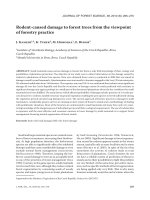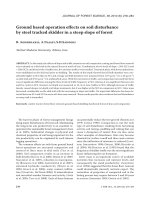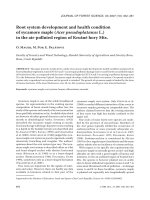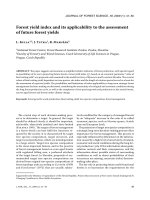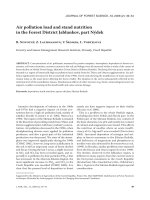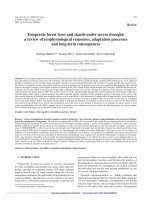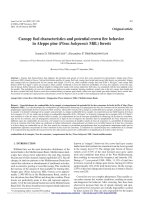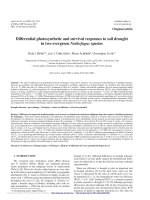Báo cáo lâm nghiệp: "of morphological characters and molecular markers for the analysis of hybridization in sessile and pedunculate oak" pps
Bạn đang xem bản rút gọn của tài liệu. Xem và tải ngay bản đầy đủ của tài liệu tại đây (744.63 KB, 13 trang )
Original
article
Comparison
of
morphological
characters
and
molecular
markers
for
the
analysis
of
hybridization
in
sessile
and
pedunculate
oak
R Bacilieri,
A
Ducousso*
A
Kremer
Laboratoire
de
génétique
et
d’amélioration
des
arbres
forestiers,
INRA,
BP
45,
33611
Cestas-Gazinet,
France
(Received
20
October
1994;
accepted
29
August
1995)
Summary —
Interspecific
hybridization
is
common
in
many
plant
groups,
but
the
morphology
of
hybrids
has
rarely
been
studied
on an
experimental
basis.
The
sessile
and
the
pedunculate
oak
are
closely
related
species
which
can
hybridize
in
nature.
Yet,
the
morphology
of
their
hybrids
is
still
a
matter
of
conjecture.
Here
we
studied the
morphology
and
the
hybridization
rate
in
several
open-pol-
linated
progenies
collected
in
a
mixed
stand
of
sessile
and
pedunculate
oak.
For
both
species,
two
types
of
pollinating
environments
(intraspecific
and
interspecific)
were
compared
for their
morphological
and
genetic
effects
in
progenies.
The
analysis
of
the
molecular
markers
showed
that
the
contribution
of
ses-
sile
oak
to
the
progenies
of
pedunculate
oak
was
positive.
The
genetic
effect
of
the
pollinating
envi-
ronment
was
significant.
The
morphological
characters
gave
a
better
image
of
interspecific
gene
flow
when
considered
together
in
multivariate
analyses
rather
than
in
univariate
analyses.
This
probably
occurred
because
the
hybrids
were
a
mosaic
of
parental
and
intermediate
characters,
rather
than
exactly
intermediate
forms.
morphology
/
RAPD
/
hybridization
/
Quercus
Résumé —
Comparaison
des
caractères
morphologiques
et
des
marqueurs
moléculaires
pour
l’analyse
de
l’hybridation
entre
les
chênes
sessile
et
pédonculé.
L’hybridation
interspécifique
est
un
phénomène
courant
chez
de
nombreux
groupes
végétaux,
mais
la
morphologie
des
hybrides
a
été
rarement
étudiée
sur
des
bases
expérimentales.
Les
chêne
sessile
et
pédonculé
sont
deux
espèces
étroitement
apparentées,
qui
peuvent
naturellement
s’hybrider.
Toutefois,
la
morphologie
de
leurs
hybrides
reste
encore
peu
connue.
Dans
ce
travail
nous
étudions
la
morphologie
et
le
taux
d’hybridation
chez
les
descendances
issues
de
pollinisation
libre
récoltées
dans
un
peuplement
naturel
de
chêne
ses-
sile
et pédonculé.
Les
effets
de
l’environnement
pollinique
intra
ou
interspécifique
ont
été
étudiés
à
l’aide
de
la
morphologie
foliaire
et
de
marqueurs
moléculaires.
Ces
derniers
ont
montré
que
la
contribution
du
chêne
sessile
aux
descendances
de
chêne
pédonculé
est
significativement
positive
mais
pas
l’in-
verse.
Les
effets
génétiques
des
différents
environnements
polliniques
sont
significatifs.
Les
caractères
*
Correspondence
and
reprints
morphologiques
donnent
une
meilleure
image
du
flux
génique
interspécifique
quand
ils
sont
considérés
globablement
dans
une
analyse
multivariée
que
lorsqu’ils
sont
considérés
séparement
dans
une
ana-
lyse
univariée.
Ce
résultat
laisse
penser
que
les
hybrides
sont
une
mosaïque
de
caractères
parentaux
et
intermédiaires,
plutôt
que
des
formes
exactement
intermédiaires.
morphologie / RAPD / hybridation / Quercus
INTRODUCTION
Natural
interspecific
hybridization
has
long
been
recognized
as
a
common
phe-
nomenon
in
many
plant
groups
(Stebbins,
1950;
Lewontin
and
Birch,
1966;
Grant,
1984).
It
has
been
traditionally
assumed
that
natural
hybrids
should
have
an
inter-
mediate
morphology
between
that
of
the
parental
species
(Anderson,
1953).
Never-
theless,
this
hypothesis
has
rarely
been
ver-
ified
experimentally.
Recently,
reviewing
the
effects
of
interspecific
gene
flow
on
plant
morphology,
Rieseberg
and
Ellstrand
(1993)
showed
that
hybridization
does
not
always
produce
intermediate
forms.
In
approxi-
mately
half
of
the
cases
studied,
the
hybrids
are
more
like
1
of
the
parental
species
or
present
phenotypic
novelties.
Sessile
(Quercus
petraea
(Matt)
Liebl)
and
pedunculate
oaks
(Quercus
robur L)
are
closely
related
species
with
a
wide
sym-
patric
distribution
in
Europe.
They
are
wind-
pollinated
and
nearly
completely
outcrossing
species
(Bacilieri
et al,
1996).
They
present
slight
differences
in
a
series
of
morpholog-
ical
characters.
The
differences
in
the
char-
acters
of
the
leaves
and
seeds
are
usually
used
in
the
literature
to
discriminate
between
the
two
species
(Gardiner,
1970;
letswaart
and
Feij,
1989).
Interspecific
gene
flow
between
sessile
and
pedunculate
oak
has
been
inferred
in
many
studies
on
the
basis
of
the
finding,
in
natural
mixed
populations,
of
trees
with
intermediate
morphology
(Rushton,
1978, 1979;
Minihan
and
Rush-
ton,
1984;
Semerikov
et al,
1988;
letswaart
and
Feij,
1989).
Hypothesis
of
hybridization
between
these
two
species
is
supported
by
the
success
of
interspecific
controlled
crosses
(Rushton,
1977;
Aas,
1991;
Stein-
hoff,
1993).
However,
the
morphology
of
true
hybrids
has
still
not
been
studied.
Among
the
reasons
for
this,
is
the
fact
that
interspecific
controlled
crosses
are
difficult
to
certify
free
from
intraspecific
pollution,
and
no
species-specific
markers
have
yet
been
identified.
The
allelic
forms
of
genetic
markers
such
as
allozymes
or
RAPDs
present,
at
best,
only
small
differences
in
frequencies
between
sessile
and
pedunculate
oak
(Kre-
mer
et al,
1991;
Bacilieri
et al,
1996;
Moreau
et
al,
1994).
If
these
types
of
markers
can-
not
be
used
to
directly
identify
the
hybrids,
nevertheless
the
differences
in
frequencies
between
species
can
be
exploited
to
esti-
mate,
in
mixed
forests,
the
parental
genetic
contribution
to
the
progenies.
This
was
done
in
a
previous
study,
in
which
by
studying
the
allozyme
distribution
in
the
seed
sets
of
1989
and
1992
of
a
mixed
oak
stand,
we
were
able
to
detect
asymmetric
gene
flow
between
sessile
and
pedunculate
oak
in
natural
conditions
(Bacilieri
et al,
1996).
The
sessile
oak
pollinated
the
pedunculate
oak
but
the
reverse
did
not
occur.
Here
we
studied
the
morphological
char-
acters
and
the
distribution
of
RAPD
markers
in
several
open-pollinated
progenies
col-
lected
in
1989
in
the
same
mixed
oak
stand
mentioned
earlier.
These
progenies
were
planted
in
a
nursery
under
homogeneous
conditions.
To
have
a
greater
probability
to
recognize
the
morphological
effects
of
hybridization,
the
families
were
chosen
in
order
of
their
provenance
in
the
stand.
The
families
generated
by
maternal
trees
encir-
cled
by
trees
of
the
same
species
(collected
in
pure
zones
of
the
stand)
were
compared
with
the
families
collected
from
maternal
trees
encircled
by
trees
of
the
other
species
(mixed
zones;
for
the
definition
of
mixed
and
pure
zones,
see
Bacilieri
et al,
1995).
Assuming
that
the
trees
mate
preferentially
with
their
neighbourhoods,
hybridization
should
be
more
frequent
in
the
mixed
zones,
and
a
difference
in
morphology
should
appear
among
groups.
These
progenies
were
analysed
for
morphological
and
genetic
markers
after
3
years
of
growth.
The
genetic
contribution
of
the
two
parental
species
to
these
progenies
were
estimated
comparing
the
RAPD
marker
frequencies
in
the
pro-
genies
and
in
adults
by
means
of
a
statisti-
cal
method
presented
previously
for
the
study
of
admixture
in
human
populations
(Roberts
and
Hiorns,
1965;
Elston,
1971).
The
study
of
the
hybridization
and
mor-
phology
of
the
hybrid
forms
in
oaks
is
impor-
tant
to
understand
the
evolution
of
these
taxa
and
of
their
genetic
resources.
Practi-
cal
consequences
concern
both
the
research
on
the
different
aspects
of
the
biol-
ogy
of
the
white
oaks,
that
are
based
on
a
preliminary
morphological
discrimination
of
the
individuals
into
species,
and
the
man-
agement
and
the
sylviculture
of
the
oak
stands,
that
present
among
their
objectives
to
furnish
homogeneous
products
(seeds,
wood,
etc).
MATERIALS
AND
METHODS
Sampling
The
stand,
situated
in
the
Petite
Charnie
Forêt
(Le
Mans,
France)
consists
of
426
adult
oak
trees
(about
50%
pedunculate
oak
and
50%
sessile
oak).
A
description
of
the
ecology
of
the
stand
and
the
taxonomic
discrimination
of
the
adult
trees
has
been
presented
elsewhere
(Bacilieri
et
al,
1995).
During
autumn
1989,
seeds
were
col-
lected
in
the
crown
of
several
open-pollinated
trees
of
the
two
species.
A
map
of
the
positions
of
the
mother
trees
in
the
stand
is
given
in
figure
1.
The
families
were
chosen
as
a
function
of
the
neighbourhood
(the
ten
nearest
trees)
of
their
maternal
trees
(the
symbols
in
parentheses
iden-
tify
each
group):
-
11
sessile
oaks
encircled
by
trees
of
the
same
species
(ses/ses);
families:
3, 14, 17,
26,
31, 113,
115, 122, 134,
140,
142;
the
neighourhood
was
composed,
on
average,
of
85.5%
sessile
oaks;
—
nine
pedunculate
oaks
encircled
by
trees
of
the
same
species
(ped/ped);
families:
220,
222,
225,
237, 246, 247, 249,
369,
372;
the
neighbourhood
was
composed,
on
average,
of
90.0%
peduncu-
late
oaks;
—
ten
sessile
oaks
encircled
by
pedunculate
oaks
(ses/ped);
families:
166, 195,
204,
206,
210,
240,
241,
323,
342, 396;
the
neighbourhood
was
com-
posed,
on
average,
of
67.8%
pedunculate
oaks;
—
7
pedunculate
oaks
encircled
by
sessile
oaks
(ped/ses);
families:
42, 97,
106,
159,
161,
174,
324;
the
neighbourhood
was
composed,
on
aver-
age,
of
60.0%
sessile
oaks.
The
seeds
were
germinated
in
an
incubator,
and
then
transferred
to
the
nursery
of
Pierroton
(Bordeaux).
The
progenies
were
randomly
dis-
tributed
in
the
nursery,
in
one
unitary
parcel
with-
out
repetitions.
During
the
summer
1992,
3
years
after
germination,
a
number
of
leaves
was
sam-
pled
on
each
of
the
seedlings
of
the
37
families
for
the
morphological
analysis.
The
hybridization
rate
was
calculated
by
means
of
the
comparison
of
the
RAPD
marker
frequencies
of
a
subsampling
of
these
progenies
and
of
the
adult
population.
Analysis
of
the
morphological
characters
The
41
morphological
characters
used
here
are
listed
in
table
I.
These
characters
were
measured
on
three
leaves
per
plant.
For
each
family,
we
studied
five
randomly
chosen
seedlings.
To
deter-
mine
if
the
groups
presented
morphological
dif-
ferences,
the
means
of
the
morphological
char-
acters
were
compared
by
means
of
an
F-test
(Sokal
and
Rohlf,
1981).
The
variables
30,
31,
32,
33
were
converted
by
a
square
root
and
the
frequencies
by
the
angular
conversion
arcsin
√x
(Sokal
and
Rohlf,
1981).
The
homogeneity
of
the
intragroup
variances
was
analysed
with
the
Bartlett
test
(Sokal
and
Rohlf,
1981).
The
morphological
data
were
further
analysed
with
different
types
of
discriminant
factorial
anal-
ysis
(DFA;
Legendre
and
Legendre,
1984).
First,
all
the
individuals
and
all
the
characters
were
included
in
the
analysis
(DFAa).
Second,
the
indi-
viduals
of
the
groups
ses/ses and
ped/ped
were
considered
as
principal
points,
and
individuals
of
the
mixed
zones
ped/ses
and
ses/ped
as
sup-
plementary
points
(DFAb).
In
the
third
DFA,
only
characters
independent
of
the
dimensions
of
the
leaves
were
considered
(character
numbers
20,
23, 26,
29,
32,
33, 35,
36,
37, 39,
40, 41;
DFAc).
Since
we
did
not
dispose
of
repetitions,
it
was
impossible
to
estimate
the
experimental
error
due
to
the
environmental
differences
in
nursery.
Nev-
ertheless,
this
error
was
probably
small,
as
the
families
were
randomly
distributed
in
the
nursery
and
the
cultural
interventions
in
nursery
tended
to
homogenize
growth
conditions.
Molecular
analysis
The
RAPD
method
(Williams
et al,
1990;
Welsh
et
al,
1991)
consists
of
amplifying
part
of
the
DNA
of
an
individual
with
the
PCR
technique
(polymerase
chain
reaction),
using
nucleotidic
primers
of
small
size
(ten
bases).
The
nucleotide
sequences
of
these
primers
are
chosen
at
random.
With
this
method,
the
amplification
takes
place
only
if
the
two
primers
are,
on
the
chromosomes,
at
a
dis-
tance
inferior
than
2
to
3
Kb.
The
amplification
products
are
then
separated
on
agarose
or
acry-
lamide
gels
with
electrophoretic
methods.
The
polymorphisms
revealed
by
RAPDs
correspond
generally
to
the
presence
or
the
absence
of
the
amplified
fragments.
A
simple
genetic
event,
such
as
a
mutation
or
a
deletion,
at
the
level
of
the
primer
site
on
the
genome
is
sufficient
to
impede
the
amplification.
Then,
two
alleles
at
each
locus
are
detected:
the
allele
defined
by
the
presence
of
the
amplified
fragment
(+),
and
the
allele
asso-
ciated
with
the
absence
of
the
fragment,
called
null
allele
(n).
Since
the
amplifications
are
run
in
saturated
conditions,
the
genotypes
+/n
and
+/+
are
confounded
(in
the
phenotype
A+).
With
this
technique,
Moreau
et
al
(1994)
found,
by
analysing
several
mixed
oak
populations
(among
which
is
the
Petite
Charnie
stand),
12
bands
among
419,
allowing
discrimination
between
sessile
and
pedunculate
oaks.
Among
these
12
bands,
two
(F14a
and
174g)
were
pre-
sent
in
small
frequencies
in
pedunculate
oak
and
in
high
frequencies
in
sessile
oak.
The
Mendelian
heredity
of
the
2
fragments
F14a
and
174g
was
verified
in
intra-
and
interspecific
controlled
crosses
(Moreau
et
al,
1994).
Both
fragments
were
dominant
over
their
respective
null
alleles.
As
these
fragments
have
a
dominant
expres-
sion,
information
on
the
interspecific
gene
flow
could
be
obtained
only
from
the
progenies
born
by
maternal
trees
with
genotype
n/n.
In
these
pro-
genies,
the
amplified
fragment
(+)
found
in
the
phenotype
A+
was
brought
by
the
pollen
which
fertilized
the
ovule.
The
seedlings
in
which
the
band
was
present
were
all
heterozygotes;
their
frequency
corresponded
to
the
frequency
of
the
(+)
allele
in
the
pollen
pool.
The
necessity
to
dis-
pose
of
families
with
maternal
genotype
n/n
restricted
the
number
of
the
primers
to
the
two
cited
earlier,
F14a
and
174g.
The
DNA
was
extracted
from
dormant
buds
of
adults
and
seedlings,
amplified
and
then
migrated
on
acrylamide
gels
following
Moreau
et
al
(1994).
In
the
adult
populations,
we
sampled
41
sessile
oaks
and
45
pedunculate
oaks.
The
allelic
frequencies
of
the
RAPD
markers
in
the
adult
populations
were
estimated
both
considering
that
these
populations
were
at
the
Hardy-Weinberg
equilibrium,
and
under
the
hypothesis
that
a
het-
erozygote
deficit
were
present
in
the
stand,
as
described
with
allozyme
markers
by
Bacilieri
et al
(1994).
In
the
first
case,
allelic
frequencies
(p
n
and
p+)
were
estimated
on
the
basis
of
the
fre-
quencies
of
the
genotype
n/n
(P
n/n
).
In
the
second
case
of
the
figure,
the
het-
erozygote
deficit
(f)
must
be
considered.
The
fre-
quency
of
the
phenotype
A+
is
the
sum
of
the
frequency
of
the
genotype
P
+/+
:
and
of
the
genotype
P
+/n
:
Knowing
the
frequency
PA+
of
the
phenotype
A+
and
f,
the
frequency
of
the
allele
p+
could
be
found
solving
the
equation:
This
equation
has
2
solutions,
but
1
is
always
greater than
unity,
if
f
> 0,
as
was
the
case
here.
As
the
hybridization
was
asymmetric
(pollen
of
sessile
oak
versus
ovules
of
pedunculate
oak;
Bacilieri
et al,
1996),
with
the
RAPD
markers
we
studied
only
the
pedunculate
oak
progenies.
Allele
frequencies
have
been
estimated
in
a
subsample
of
84
individuals
from
six
pedunculate
oak
pro-
genies
(3
ped/ped
and
3
ped/ses)
whose
parents
were
homozygotes
n/n
for
the
two
fragments.
The
relative
genetic
contribution
of
the
two
parental
populations
(sessile
and
pedunculate
oaks)
to
the
pedunculate
oak
progenies
was
esti-
mated
using
a
least-squares
procedure
devel-
oped
to
describe
gene
flow
among
human
pop-
ulations
(Roberts
and
Hiorns,
1965;
Elston,
1971).
The
procedure
uses
a
matrix X of
the
allele
fre-
quencies
for
two
parental
populations
and
a
row
vector
y of
allele
frequency
differences
between
the
progeny
and
the
parental
population.
The
least-squares
estimate
of
gene
admixture,
m,
is
a
row
vector
defined
as:
provided
X’X
is
nonsingular.
The
least-squares
estimates
of
the
proportion
of
genes
derived
from
each
parental
population
are
the
elements
of
m.
The
m
(0
≤ m
≤ 1)
is
then
an
estimate
of
the
hybrid
frequency.
Standard
errors
of
m
were
used
in
two-tailed
t-tests
of
the
null
hypothesis
Ho:
m
=
0
(no
hybridization).
RESULTS
Morphological
analysis
All
of
the
41
morphological
characters
stud-
ied
showed
an
unimodal
distribution
at
the
within-group
level.
Among
all
of
these
char-
acters,
31
present
significant
differences
between
sessile
and
pedunculate
oak
for
the
F-test
(table
II).
Within the
sessile
oak
species,
14
of
these
31
variables
had
a
dis-
tribution
significantly
different
between
groups
ses/ses
and
ses/ped.
In
the
group
ses/ped,
12
of
these
14
variables
showed
a
shift
of
the
mean
in
the
direction
of
the
other
species,
the
pedunculate
oak.
In
peduncu-
late
oak,
12
variables
showed
a
significant
difference
between
groups;
in
the
group
ped/ses,
all
the
variables
showed
a
shift
in
the
direction
of
the
sessile
oak.
The
probability
to
observe
a
similar
dis-
tribution
(12/14
and
12/12),
in
a
binomial
distribution
where
the
two
events
(p
> mean,
q
<
mean)
have
the
same
probability
(p
=
q
=
0.5)
is
very
small
(sign
test:
P
<
0.001;
Sokal
and
Rohlf,
1981).
We
may
reject
the
hypothesis
Ho
that
the
observed
differences
were
exclusively
due
to
chance.
The
comparison
of
the
variances
of
the
variables
showed
a
few
differences
between
pollen
neighbourhoods.
The
vari-
ances
of
the
variables
of
the
progenies
from
the
mixed
neighbourhoods
ses/ped
and
ped/ses
were
either
greater
(two
cases
in
both
species)
or
smaller
(three
cases
in
both
spcies)
than
those
of
the
progenies
ses/ses
and
ped/ped,
respec-
tively.
The
sign
test
did
not
show
any
direc-
tionality
in
this
case
(results
not
shown).
The
means
and
the
variances
of
the
mor-
phological
characters
of
the
maternal
plants
showed
no
significant
differences
between
groups
within
species
(results
not
shown).
The
discriminant
analysis
conducted
over
all
the
individuals
and
all
the
characters
(DFAa)
separated
the
seedlings
into
two
groups
along
the
first
axis.
This
axis
explained
33%
of
the
total
variance
and
the
second,
6%.
The
characters
normally
used
to
recognize
the
species
were
strongly
cor-
related
to
the
first
axis
(Ipet,
pillimb,
nblob,
etc;
table
III).
These
characters
corre-
sponded
to
those
found
in
a
previous
study
to
best
discriminate
the
adult
trees
of
the
two
species
(Bacilieri
et
al,
1995),
except
tetmoy
which,
in
our
sample,
did
not
con-
tribute
to
the
first
axis
in
progenies.
We
may
identify
the
two
groups
ordered
by
DFA
as
corresponding
to
the
two
species,
sessile
and
pedunculate
oak.
The
progenies
were
classified
in
the
two
groups
as
it
was
expected
knowing
the
two
species
of
their
maternal
parent
tree,
except
two
seedlings
of
the
family
396
(with
sessile
oak
mater-
nal
parent
in
pedunculate
oak
zone),
one
of
the
family
174
and
one
of
the
family
97
(with
pedunculate
oak
as
maternal
parent
in
sessile
oak
zone)
which
fell
in
the
space
of
the
other
species.
The
distribution
of
the
seedlings
on
the
first
axis
of
DFAs
is
shown
in
figure
2a.
The
group
ped/ses
had
a
bimodal
distribution,
the
second
peak
of
which
was
situated
on
the
side
of
the
species
in
the
majority
rep-
resented
in
the
neighbourhood,
the
sessile
oak.
The
comparison
of
the
mean
values
of
the
groups
on
the
first
axis
of
DFAa
by
means
of
the
F-test
showed
a
significant
difference
between
the
two
groups
of
pedun-
culate
oak
progenies
(F =
6.215,
ddl
=
1
and
81;
P =
0.001);
the
mean
values
on
the
first
axis
of
the
groups
ped/ped
and
ped/ses
were,
respectively,
0.017
and
0.014.
In
con-
trast,
no
differences
were
found
in
the
two
sessile
oak
groups
(F =
0.891,
ddl =
1
and
100;
P =
0.650).
In
DFAb,
where
only
the
individuals
of
the
pure
zones
were
used
as
principal
points
of
the
analysis,
the
discrimination
between
species
was
improved.
The
first
axis
explained,
in
this
case,
39%
of
the
total
vari-
ance.
The
two
groups
of
the
mixed
zones
(ped/ses
and
ses/ped)
presented
again
a
bimodal
distribution,
the
second
peak
being
situated
in
both
cases
on
the
side
of
the
other
species
(fig
2b).
The
comparison
of
the
mean
values
on
the
first
axis
showed
significant
differences
in
both
groups
of
the
2
species
(P
=
0.016
in
sessile
oak,
P
<
0.001
in
pedunculate
oak).
In
DFAc,
the
first
axis
explained
51.6%
of
the
total
variance.
The
bimodal
distribution
was
shared
by
the
two
groups
of
peduncu-
late
oak.
In
contrast,
the
two
groups
of
ses-
sile
oak
had
a
very
similar
unimodal
distri-
bution
(fig
2c).
The
difference
between
the
means
of
the
groups
was
significant
in
pedunculate
oak
(P
=
0.005),
and
not
sig-
nificant
in
sessile
oak.
In
pedunculate
oak
progenies,
the
seedlings
falling
in
the
sessile
oak
group
were
the
same
over
the
three
analyses.
Con-
versely,
in
sessile
oak
only
one
individual
of
the
family
97
remained
classified
in
the
space
of
the
other
species
over
the
3
analyses.
Molecular
analyses
The
allele
frequencies
of
the
RAPD
loci
in
the
adult
trees
of
the
stand,
calculated
according
to
the
two
hypotheses:
i)
popu-
lations
at
the
Hardy-Weinberg
equilibrium,
and
ii)
not
at
the
equilibrium,
are
shown
in
table
IV,
as
well
as
the
allele
frequencies
in
the
pollen
pool.
The
genetic
contribution
of
the
sessile
oak
to
the
pedunculate
oak
was
estimated
to
be
positive,
independent
of
the
population
of
reference
used
(table
V).
This
contribution
was
greater
in
the
mixed
zone
(ped/ses)
than
in
the
pure
zone
(ped/ped).
The
comparison
of
the
standard
errors
of
the
estimations
showed
that
this
difference
between
zones
was
significant.
DISCUSSION
AND
CONCLUSION
The
study
of
the
molecular
markers
showed
that
the
contribution
of
sessile
oak
to
the
pedunculate
oak
progenies
was
significantly
positive.
The
hybridization
rate
obtained
with
RAPDs
had
the
same
magnitude
of
the
rate
observed
with
allozymes
in
the
seeds
and
natural
regeneration
of
the
same
stand
(Bacilieri
et al,
1994).
This
result
confirms
that
hybridization
occurs
in
nature
and
hybrids
survive
to
the
first
stage
of
life.
Both
in
sessile
and
pedunculate
oak,
the
seedlings
showed
significant
morphologi-
cal
differences
between
the
intraspecific
groups.
However,
the
larger
part
of
the
dif-
ferences
between
groups
was
found
in
char-
acters
linked
to
the
size
of
the
leaf
rather
than
to
the
discrimination
between
species.
The
characters
with
the
stronger
power
of
discrimination
between
species
(this
power
being
measured
by
the
correlations
with
the
first
axis
of
DFA)
did
not
show
differentia-
tion
between
groups,
except
pillimb
in
pedunculate
oak
and
Ipet:Ilimb
and
nblod:peri
in
sessile
oak.
These
latter
two
characters
showed
a
shift
in
their
means
contrary
to
that
expected
under
the
hybridization
hypothesis.
On
the
other
hand,
differentiation
of
the
size
of
the
leaf
between
ecological
zones
of
the
parcel
had
already
been
observed
in
adult
trees:
in
both
species,
individuals
from
the
wetter
area
have
the
larger
leaves
(although
these
differences
were
not
sig-
nificant
by
the
statistical
tests;
Bacilieri
et
al,
1995).
Considered
together
with
the
uni-
modal
distribution
of
the
single
characters
at
the
within-group
level,
these
results
indicate
that
the
morphological
differences
between
groups
were
probably
independent
from
the
interspecific
gene
flow,
but
rather
related
to
differences
in
the
ecological
environment
of
maternal
trees.
In
northern
red
oak,
Sork
et
al
(1993)
showed
that
genetic
differentiation
for
insect
resistance
occurs
over
a
short
distance,
in
response
to
environmental
heterogeneity
in
the
distribution
of
insects.
However,
our
experiment
did
not
allow
us
to
attribute
the
morphological
differentiation
to
an
environ-
mental
or
genetic
origin.
In
contrast,
when
the
morphological
char-
acters
were
analysed
together
in
a
multi-
variate
space
by
means
of
a
DFA,
they
gave
an
image
coherent
with
the
hypothesis
of
hybridization
supported
by
molecular
anal-
yses.
A
common
trait
joined
the
3
analyses
used
here:
their
first
axes
were
formed
by
almost
the
same
combination
of
characters
as
the
first
axis
of
a
DFA
on
adult
trees
(Bacileri
et
al,
1995).
However,
the
effects
of
hybridization
appear
to
be
variable
over
the
analyses.
The
DFAc,
which
included
only
the
characters
considered
independent
from
the
size
of
the
leaf,
and
in
which
the
indi-
viduals
of
the
mixed
zones
were
not
con-
sidered
in
the
construction
of
the
canonical
axes,
was
the
one
discriminating
at
best
between
sessile
and
pedunculate
oak.
This
analysis
was
also
the
one
which
best
rep-
resented
the
results
of
interspecific
gene
flow
obtained
with
allozymes
(Bacilieri
et al,
1994b)
and
RAPDs.
In
this
analysis,
the
bimodal
distributions
of
the
pedunculate
oak
was
very
pronounced.
In
contrast,
the
two
groups
of
sessile
oak
showed
a
very
similar
unimodal
distribution.
We
did
not
study
the
progenies
of
ses-
sile
oak
with
molecular
markers;
neverthe-
less,
both
the
studies
of
controlled
crosses
(Aas,
1991;
Steinhoff,
1993)
and
of
allozymes
in
progenies
(Bacilieri
et
al,
1996)
showed
that
the
gene
flow
in
these
species
is
asymmetric,
and
that
sessile
oak
can
be
fertilized
by
pedunculate
oak
with
difficulty.
In
this
study,
the
morphological
characters
were
consistent
with
the
molecular
markers,
in
showing
that
the
pedunculate
oak
can
be
hybridized
by
sessile
oak.
Furthermore,
hybridization
seems
larger
in
the
zone
of
the
stand
where
the
sessile
oak
is
predominant.
The
fact
that
the
morphological
charac-
ters
did
not
inform
on
the
effect
of
hybridiza-
tion
when
considered
individually,
but
only
when
considered
together
in
a
multivariate
analysis,
may
mean
that
they
have
a
dom-
inant
expression,
or
that
there
are
mater-
nal
effects
that
make
the
observation
of
seg-
regation
in
the
progenies
difficult.
The
hybrids,
in
this
case,
are
probably
a
"mosaic
of
parental
and
intermediate
characters"
(Rieseberg
and
Ellstrand,
1993)
and
may
be
detected
only
when
many
characters
are
used
conjointly.
The
development
of
dominance
in
char-
acters
linked
to
the
differentiation
of
inter-
fertile
species
is
frequent
(Rieseberg
and
Ellstrand,
1993).
Similarly,
its
development
has
been
predicted
by
simulation
for
those
characters
submitted
to
disruptive
selection
(Dickinson
and
Antonovics,
1973).
Theo-
retically,
dominance
may
take
place
if
the
characters
are
determined
by
a
small
num-
ber
of
genes.
On
the
other
hand,
the
mater-
nal
effects
on
juvenile
characters
have
been
shown
in
a
number
of
species,
that
is,
the
size
of
seedlings
is
frequently
related
to
the
size
of
the
seeds
from
which
they germi-
nate.
The
maternal
effects
could
also
take
their
origin
from
the
variability
of
the
cyto-
plasmic
organelles
(Blada,
1992).
In
our
experience,
the
lack
of
repetitions
did
not
allow
more
precise
conclusions.
In
spite
of
this
limit,
the
present
study
permits
us
to
show
that
the
discrimination
of
hybrids
depends
strongly
on
the
type
of
analysis
and
characters used.
If
the
DFA
was
conducted
on
seedlings
of
unknown
maternal
origin,
the
estimation
of
hybridization
based
on
mor-
phological
characters
should
have
been
much
lower
(approximately
7%
or
less).
For
the
white
oak
species
complex,
the
significance
of
our
findings
could
be
sum-
marized
as
follows:
On
the
one
hand,
the
asymmetric
interspecific
gene
flow
observed
previously
with
allozymes
(Bacilieri
et
al,
1996)
is
confirmed
with
another
genetic
marker.
This
is
important
because,
in
con-
trast
with
theoretical
predictions,
allozymes
sometimes
appear
not
to
be
neutral
in
rela-
tion
to
selection
(Karl
and
Avise,
1992;
Avise,
1994;
Pogson
and
Zouros,
1994),
biasing
estimations
of
the
population
genetic
parameters.
RAPD
markers,
relying
on
a
random
amplification
of
DNA
independent
from
the
genome
functions,
are
probably
less
sensitive
to
selection.
On
the
other
hand,
morphology
appears
not
to
be
a
completely
reliable
criterion
of
discrimination,
because
its
results
depend
on
the
type
of
analysis
and
of
the
characters
chosen,
and
on
dominant
and
maternal
effects
that
probably
hide
hybrids
among
the
trees
of
one
or
the
other
species.
The
errors
of
taxonomic
attribution
could
affect
both
the
studies
of
biological
characters
in
one
given
species,
and
the
studies
of
hybridization.
These
errors
could
be
reduced
in
size
only
by
means
of
the
comparison
of
the
distribution
of
many
kinds
of
characters
and
of
genetic
markers
in
space
(over
pop-
ulations)
and
in
time
(over
generations).
Finally,
we
have
to
consider
that
these
European
white
oak
species
present,
at
the
same
time,
an
abundant
interspecific
gene
flow
and
a
large
level
of
genetic
diversity
(Kremer
et
al,
1991).
If
the
interspecific
gene
flow
is
a
mechanism
contributing
to
main-
tain
the
genetic
diversity,
as
many
authors
have
suggested
(Stebbins,
1950;
Lewontin
and
Birch,
1966;
Grant,
1984),
the
networks
for
the
conservation
of
genetic
resources
in
European
white
oak
must
consider
the
mixed
populations
among
the
populations
to
conserve.
REFERENCES
Aas
G
(1991)
Kreuzungsversuche
mit
Stiel-
und
Traubeneichen
(Quercus
robur
L und
Q petraea
(Matt)
Liebl).
Allgemeine
Forst-
und
Jagdzeitung
162,
141-145
Anderson
E
(1953)
Introgressive
hybridization.
Biol Rev
28, 280-307
Avise
JC
(1994)
Molecular markers,
natural history and
evolution.
Chapman
and
Hall,
New
York,
NY,
USA
Bacilieri
R,
Labbé
T,
Kremer
A
(1994)
Intraspecific
genetic
structure
in
a
mixed
population
of
Quercus
petraea
(Matt)
Liebl
and
Q
robur L.
Heredity 73,
130-141
Bacilieri
R,
Ducousso
A,
Kremer
A
(1995)
Genetic,
mor-
phological,
ecological
and
phenological
differentiation
between
Quercus
petraea
(Matt)
Liebl
and
Q
robur
L
in
a
mixed
stand
of
Northwest
France.
Silvae
Genetica 44,
1-10
Bacilieri
R,
Ducousso
A,
Petit
R,
Kremer
A
(1996)
Mat-
ing
system
and
directional
gene
flow
in
a
mixed
stand
of
sessile
and
pedunculate
oak.
Evolution
(in
press)
Blada
I (1992)
Nuclear
and
extranuclear
genetic
effects
in
F1
reciprocal
hybrids
between
Pinus
strobus and
P
peuce.
Silvae
Genetica
41,
34-38
Dickinson
H,
Antonovics
J
(1973)
Theoretical
consider-
ations
of
sympatric
divergence.
Am
Nat
107, 256-
274
Elston
RC
(1971)
The
estimation
of
admixture
in
racial
hybrids.
Ann
Human
Genet 35,
9-17
Gardiner
AS
(1970)
Pedunculate
and
sessile
oak
(Quer-
cus
robur
L
and
Quercus
petraea
(Matt)
Liebl).
A
review
of
the
hybrid
controversy.
Forestry 43,
151-
160
Grant
WF
(1984)
Plant
biosystematics.
Academic
Press,
Toronto,
Canada
letswaart
JH,
Feij
AE
(1989)
A
multivariate
analysis
of
introgression
between
Quercus robur and
Q petraea
in
the
Netherlands.
Acta
Bot Neerl 38,
313-325
Karl
SA,
Avise
JC
(1992)
Balancing
selection
at
allozyme
loci
in
oysters:
implications
from
nuclear
RFLPs.
Sci-
ence 256,
100-102
Kremer
A,
Petit
R,
Zanetto
A,
Fougère
V,
Ducousso
A,
Wagner
D,
Chauvin
C
(1991)
Nuclear
and
organelle
gene
diversity
in
Quercus
robur and
Quercus
petraea.
In:
Genetic
variation
of
forest
tree
popula-
tions
in
Europe
(G
Müller-Starck,
M
Ziehe,
eds),
Sauerländer
Verlag,
Berlin,
Germany,
141-166
Legendre
G,
Legendre
P
(1984)
Écologie
numérique.
Masson,
Paris,
France
Lewontin
RC,
Birch
LC
(1966)
Hybridization
as a
source
of
variation
for
adaptation
to
new
environments.
Evo-
lution 20, 315-336
Minihan
VB,
Rushton
BS
(1984)
The
taxonomic
status
of
oaks
(Quercus ssp)
in
Breen
Wood,
Co,
Antrim,
Northern
Ireland.
Watsonia
15,
27-32
Moreau
F,
Kleinschmit
J,
Kremer
A
(1994)
Molecular
differentiation
between
Quercus
petraea
and
Q
robur
assessed
by
random
amplified
DNA
fragments.
For-
est
Genetics
1, 51-64
Pogson
GH,
Zouros
E
(1994)
Allozyme
and
RFLP
het-
erozygosities
as
correlates
of
growth
rate
in
the
scal-
lop
Placopecten
magellanicus:
a
test
of
the
associative
overdominance
hypothesis.
Genetics 137,
221-231
Rieseberg
LH,
Ellstrand
NC
(1993)
What
can
molecular
and
morphological
markers
tell
us
about
plant
hybridization?
Crit
Rev
Plant
Sci
12,
213-241
Roberts
DF,
Hiorns
RW
(1965)
Methods
of
analysis
of
the
genetic
composition
of
a
hybrid
population.
Human
Biology 37,
38-43
Rushton
BS
(1977)
Artificial
hybridization
between
Quer-
cus
robur
L and
Quercus petraea
(Matt)
Liebl.
Wat-
sonia
11,
229-236
Rushton
BS
(1978)
Quercus
robur
L and
Quercus
petraea
(Matt)
Liebl:
a
multivariate
approach
to
the
hybrid
problem.
1.
Data
acquisition,
analysis
and
interpretation.
Watsonia
12,
81-101
Rushton
BS
(1979)
Quercus
robur
L and
Quercus
petraea
(Matt)
Liebl:
a
multivariate
approach
to
the
hybrid
problem.
2.
The
geographical
distribution
of
population
types.
Watsonia
13,
209-224
Semerikov
LF,
Glotov
NV,
Zhivotovskii
LA
(1988)
Exam-
ple
of
effectiveness
of
analysis
of
the
generalized
variance
of
traits
in
trees.
Soviet
Journal
of
Ecology
18, 140-143
Sokal
RR,
Rohlf
FJ
(1981)
Biometry,
2nd
edn,
Freeman
&
Co,
New
York,
NY,
USA
Sork
VL,
Stowe
KA,
Hochwender
C
(1993)
Evidence
for
local
adaptation
in
closely
adjacent
subpopula-
tions
of
northern
red
oak
(Quercus
rubra
L)
expressed
as
resistance
to
leaf
herbivores.
Am
Nat
142, 928-936
Stebbins
GL
(1950)
Variation
and
evolution
in
plants.
Columbia
Univ
Press,
New
York,
NY,
USA
Steinhoff
S
(1993)
Results
of
species
hybridization
with
Quercus
robur
L
and
Quercus
petraea
(Matt)
Liebl.
In:
Genetics
of oaks
(A
Kremer,
PS
Savill,
KC
Steiner,
eds),
Elsevier,
Paris,
France
Welsh
J,
Honeycutt
RJ,
McClelland
M,
Sobral
BWS
(1991)
Parentage
determination
in
maize
hybrids
using
the
arbitrarily
primed
polymerase
chain
reac-
tion
(AP-PCR).
Theor Appl Genet 82, 473-476
Williams
JGK,
Kubelik
AR,
Livak
KJ,
Rafalski
JA,
Tingey
SV
(1990)
DNA
polymorphisms
amplified
by
arbi-
trary
primers
are
useful
as
genetic
markers.
Nucleic
Acid Res 18, 6531-6535
